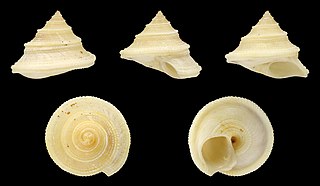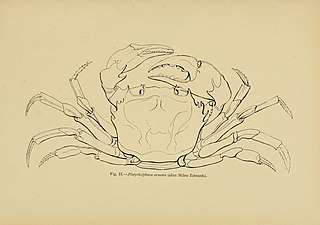
Lake Tanganyika is an African Great Lake. It is the second-oldest freshwater lake in the world, the second-largest by volume, and the second-deepest, in all cases after Lake Baikal in Siberia. It is the world's longest freshwater lake. The lake is shared between four countries—Tanzania, the Democratic Republic of the Congo (DRC), Burundi, and Zambia, with Tanzania (46%) and DRC (40%) possessing the majority of the lake. It drains into the Congo River system and ultimately into the Atlantic Ocean.

Lake Towuti is a lake in East Luwu Regency, South Sulawesi province, Indonesia. Surrounded by mountains, it is the largest lake of the island of Sulawesi and one of the five lakes of the Malili Lake system. A river flows from the lake to the Boni Bay. The town Laronda is located on its shore.

Edgar Albert Smith was a British zoologist, a malacologist.

The spotfin goby cichlid is an African species of cichlid endemic to Lake Tanganyika where it is only known from the northern end of the lake. They live amongst pebbles in the surf-zone. This species can reach a length of 7 centimetres (2.8 in) TL. This species can also be found in the aquarium trade. Although presently considered the only species in the genus, another undescribed species is known from the Lukuga River.
Anceya is a genus of tropical freshwater snails with an operculum, aquatic gastropod mollusks in the family Paludomidae.

Chytra kirki is a species of tropical freshwater snail with an operculum, aquatic gastropod mollusk in the family Paludomidae.
Coelatura horei is a species of freshwater mussel, an aquatic bivalve mollusk in the family Unionidae, the river mussels.
Ferrissia tanganyicensis is a species of small freshwater snail or limpet, an aquatic gastropod in the family Planorbidae.
Limnotrochus is a monotypic genus in the family Paludomidae containing the single species Limnotrochus thomsoni, a tropical freshwater snail with gills and an operculum, aquatic gastropod mollusk. It is endemic to Lake Tanganyika.
Martelia tanganyicensis is a species of tropical freshwater snail with an operculum, aquatic gastropod mollusc in the family Paludomidae.
Martelia is a genus of tropical freshwater snails with an operculum, aquatic gastropod molluscs in the family Paludomidae.
Reymondia horei is a species of freshwater snail with an operculum, an aquatic gastropod mollusk in the family Paludomidae. This species is found in Burundi, the Democratic Republic of the Congo, Tanzania, and Zambia. Its natural habitat is freshwater lakes.
Reymondia tanganyicensis is a species of freshwater snail in the family Paludomidae. It is endemic to Lake Tanganyika, where it is known from six locations within Burundi and Tanzania. It lives in shallow areas of the lake up to 3 meters deep, where it can be found under rocks. It is threatened by pollution and sedimentation in the lake.
Tanganyicia rufofilosa is a species of tropical freshwater snail with an operculum, an aquatic gastropod mollusk in the family Paludomidae.

Tiphobia horei is a species of freshwater snail with an operculum, an aquatic gastropod mollusk in the family Paludomidae.

Platythelphusa is a genus of freshwater crabs endemic to Lake Tanganyika. It has been placed in a number of families, including a monotypic family, Platythelphusidae, as well as Potamidae and its current position in the Potamonautidae, and has also been treated as a subgenus of Potamonautes. It forms a monophyletic group, possibly nested within the genus Potamonautes, which would therefore be paraphyletic. The genus is the only evolutionary radiation of crabs to have occurred in a freshwater lake, and it occurred recently, probably since the Pliocene. This parallels the better known radiation of cichlid fishes in Lake Tanganyika. Only one other species of freshwater crab is found in Lake Tanganyika, Potamonautes platynotus.

Mastacembelus ellipsifer is a species of spiny eel that is endemic to Lake Tanganyika in Africa and sometimes kept in aquariums. Although sometimes called the Tanganyikan spiny eel, it is only one of fifteen spiny eel species in the Tanganyikan basin.

Paludomidae, common name paludomids, is a family of freshwater snails, gastropod molluscs in the clade Sorbeoconcha.

Etheria is a genus of freshwater oysters in the Etheriidae family of mollusk bivalves, and a part of the Unionida order. The genus includes a single species, Etheria elliptica, that is found throughout Africa and Madagascar.
Caridina spongicola is a small species of freshwater shrimp from Sulawesi (Indonesia) that reaches 0.64 to 1.27 cm in length. In the wild it strictly lives on an undescribed species of freshwater sponge, making it one of only two known commensal species of freshwater shrimp. It is popularly known as the harlequin shrimp, and also sometimes Celebes beauty shrimp or sponge shrimp in the aquarium trade. It is often confused with Caridina woltereckae, a larger and more contrastingly colored species found in the same region as C. spongicola.










